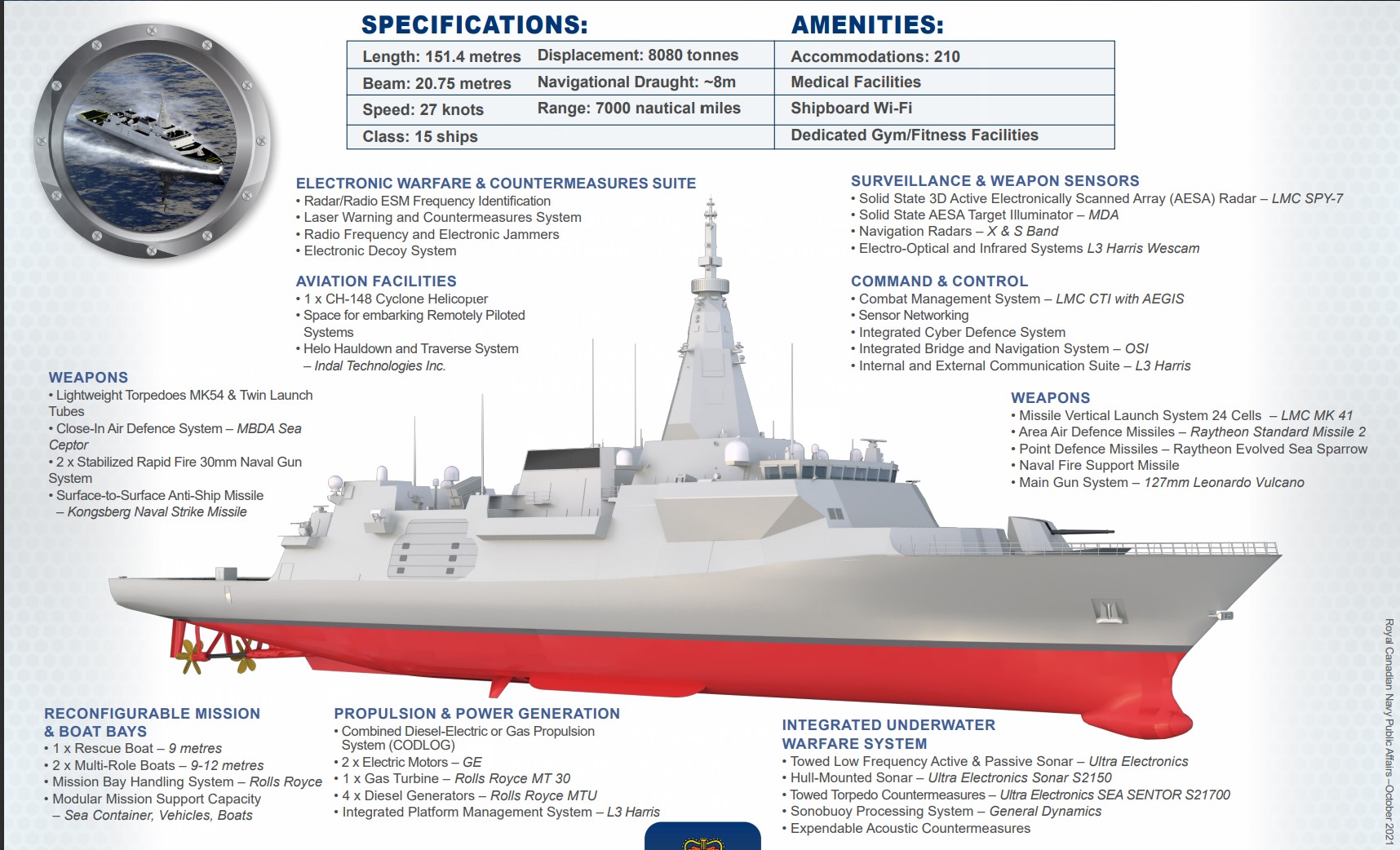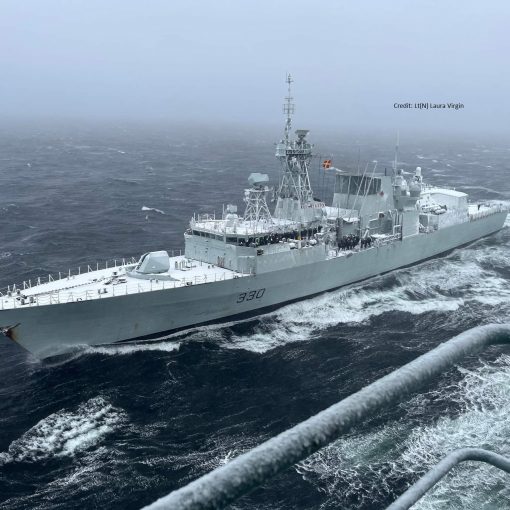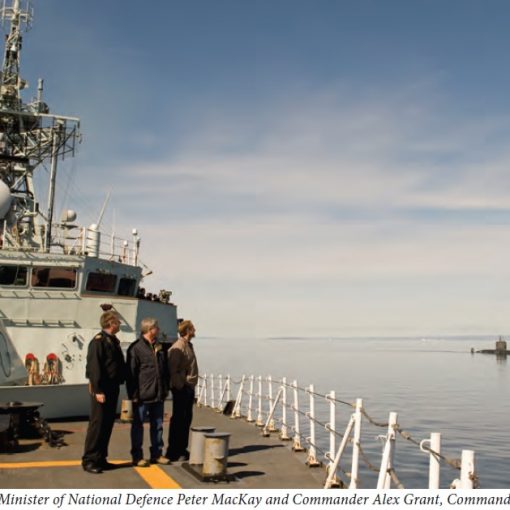By Dan Middlemiss, 19 November 2023
In its written submission to the House of Commons Standing Committee on National Defence (dated 7 November, published 16 November 2023), Irving Shipbuilding noted the following in the section entitled “Challenges”:
Canadian Surface Combatant design needs to mature faster before construction begins
One of the greatest lessons we learned from the Arctic and Offshore Patrol Ship program is the need to have a mature design before commencing construction of a new class of ship. Construction on AOPS 1 was started before Canada had a mature design, this created a number of challenges with the first few vessels in the class. As stated above, we have hit our stride on the Arctic and Offshore Patrol Ship program. We believe we could have done so earlier in the schedule if we had started with a mature design. The Canadian Surface Combatant will be a much more complex vessel than the Arctic and Offshore Patrol Ship, making it even more important to begin construction with a design which enables effective and efficient production.
Recommendation: Canada, the Navy and Industry need to work together to ensure design maturity on the Canadian Surface Combatant before construction commences.[1]
This is an intriguing observation for a number of reasons. First, it endorses the argument of the virtues of a ‘mature design’ approach to naval shipbuilding. Chief among these is the belief that proven designs bring fewer surprises, and therefore lead to fewer unexpected changes – which can induce extra costs and production delays – during the construction process. As a result, program risks are reduced, while costs can be more accurately forecast, delivery schedules more reliably predicted, and performance capabilities and quality control better guaranteed.
But what about Irving’s stated concerns about AOPS? According to an Ottawa-commissioned report by an independent consulting firm, the AOPS was far from a complex design, and therefore should not have posed the types of design challenges Irving now claims.[2]
Second, on the face of it, this statement could be taken as no more than a shipbuilder reiterating a well known adage in naval construction, namely that to minimize production risks, at some point before steel is actually cut, a warship’s design needs to be frozen with no further modifications permitted. However, this principle seems to be honoured more in the breach than in the observance. The military customer always seems to want a bit extra in capabilities, while shipbuilders sometimes showcase the technological marvels they can produce if given the opportunity. Taken together, these impulses tend to follow the maxim that ‘The last 10 percent of performance generates one-third of the cost and two-thirds of the problems.’[3]
For example, in its FFG(X) design competition, the US Navy insisted that the competition would be open to only those bidders with a proven, ‘parent-design.’ This provision therefore ruled out a bid by BAE for its Type 26 frigate. The USN, nonetheless, still requested some changes to the winning Fincantieri/Marinette Marine (F/MM)-FREMM parent design.
In a similar vein, in 2016 Ottawa announced “a streamlined and transparent approach” to accelerate the delivery of the new combatants to the RCN by up to two years. The government anticipated that this “refined procurement approach” would allow Canada to select an existing warship design to modify rather than continuing with the approach of selecting a Warship Designer and a Combat Systems Integrator to custom design the ships.[4]
This new approach was immediately endorsed by the then Irving Shipbuilding CEO, Kevin McCoy, who predicted major savings after the news announcement. According to him, “You’re essentially saving 10 per cent of the cost if you can knock two years off the time period.... A modern warship costs over $2 billion to design from scratch.... Canada will not have to pay that money. There will be some licence fees still to be determined during the procurement process, but think of the effort it takes to design a warship from scratch. Canada won’t have to go through that.”[5]
Interestingly, certain Canadian defence firms were concerned that this new approach would limit them to bid on relatively low-tech, metal-bashing contracts in the 24 designated areas being set aside for these companies.[6] As a result, they immediately began to lobby federal cabinet ministers for access to the more lucrative contracts.[7] In the face of this industry pressure, Ottawa reversed itself and the ‘mature design’ approach of June 2016 was abandoned by fall 2016. BAE’s Type 26 entrant in the CSC design selection process was allowed to compete on the grounds that BAE was one the pre-qualified firms, and because its design was ‘mature’ in the sense that it had passed the preliminary design phase and had substantially completed the detailed design of the ship.
Third, and following from this last point, it is clear that early on in the CSC design selection process, ‘design maturity’ had become a very malleable concept. Exceptions were to be permitted on several grounds, most notably ‘Canadianization,’ to meet unique Canadian warship requirements, such as crew accommodations, safety and pollution prevention regulations, and so on. Additionally, designs could be altered to allow greater Canadian content in the area of Industrial and Technological Benefits (ITB) objectives.[8] Finally, political and budgetary constraints might require reconsideration (i.e. deletions) of preferred design elements in order to meet the available funds.
Ottawa could have mitigated the risks inherent in these late-stage design changes by stepping in to freeze the design at an earlier point. However, it seems clear that DND, and the RCN in particular, were determined to have a cutting-edge warship and so were requesting design changes. Indeed, as one observer noted, a process of continuous design modification was baked into post-bid selection process.[9] In addition, as was the case for the USN’s Constellation-class frigate program, Ottawa could have reduced some of the CSC project risks by stipulating a sizeable amount of Government Furnished Material, consisting of well-proven systems and components. Ottawa chose not to do so.[10]
Taking all these factors into account, and returning to Irving’s Recommendation cited earlier, perhaps Irving was really aiming a barb at both the RCN and government to stop interfering with the design consolidation process with unending requests for modifications, to authorize the requisite funds, and to allow the shipbuilders to get on with their job of actually building the warships. Irving cannot be held accountable for cost overruns and scheduling delays when no actual build contract has been signed. Then, and only then, can the CSC design be deemed truly ‘mature,’ and program risk mitigation, price stability, and delivery schedule will be assured.
A final caveat: all of this desired predictability, of course, could well be moot because Ottawa’s reported CSC batch production approach will inevitably re-introduce the prospect of further significant design changes for the later batches.
Notes
[1]. The Committee is conducting a ‘Review of the Impact of Canada’s Procurement Process on the Canadian Armed Forces.’
[2]. Terry Milewski, “Ottawa warned about ‘very high’ price for Arctic patrol ships,” CBC News, 18 September 2013. The International Marine Consultants’ report took issue with official claims that the planned Arctic patrol ships are expensive because of their complexity. It said the specifications did not call for breaking thick winter ice or for advanced weaponry. “The AOPS is not a complicated vessel,” the report argued, “It has a relatively low ice class, a well tried AC-AC diesel electric propulsion system and fairly pedantic accommodation and on-board services and equipment.… It is not fitted with sophisticated weaponry and even its naval situation room outfitting is limited and not intended to be functional on a year-round basis.”
[3]. Norman R. Augustine, Augustine’s Laws, 6th edition, American Institute of Aeronautics & Astronautics, Inc., July 1997.
[4]. News Release, “Government announces streamlined procurement approach to accelerate delivery of Canadian Surface Combatant vessels,” Halifax, NS, 13 June 2016.
[5]. Quoted in Michael Tutton, “Federal government opts for off-the-shelf design to cut costs of new warships,” CP/CTV News, 13 June 2016.
[6]. David Pugliese, “Canadian firms shut out of high-tech work on $26-billion fleet of new warships, industry warns,” Ottawa Citizen, 6 March 2016. For the 24 designated Canadian areas, see, Canadian Surface Combatant Industry Information Session, Potential Refinement to the Procurement Strategy, 23-24 February 2016, p. 26.
[7]. Murray Brewster, “Liberals launch warship competition with call for foreign designs,” CBC News, 26 October 2016.
[8]. Ironically, some Canadian defence companies complained that the contract arrangement with Lockheed Martin Canada (LMC) meant that they were being bypassed in favour of LMC’s established supply chain partners. David Pugliese, “Top of the Line Canadian-made Naval Equipment Shut Out of $70-billion Warship Program,” Ottawa Citizen, 16 December 2020. Furthermore, there have been suggestions that Irving bears some responsibility for insisting on certification of systems the original bidder no longer has control over because they are the responsibility of other contractors, and for demanding certain companies honour their original ITB commitments even though some of those contractual items have since been eliminated.
[9]. Richard Shimooka, “No Other Option: Politics, policy, and industrial considerations in the Canadian Surface Combatant Program,” Ottawa: Macdonald-Laurier Institute, 20 December 2021), pp. 28-29.
[10]. Shimooka, “No Other Option,” pp. 21-23 and 33. As many Congressional Budget Office and Congressional Research Office reports note, the GFE costs for the Constellation-class are being held down because many of the combat and weapon system components have been developed and are in service aboard other USN warships.





9 thoughts on “The CSC and “Mature Design” Redux”
No, the AOPS was a slightly modified version of an extant Norwegian Coast Guard ship. Also, the AOPS is a civil design and not a warship like the hoped for CSC.
Hello David. The Norweigian Navy has just accepted their second OPV. It is like an AOPS but on steroids at 9,800 tonnes and has a beefed up weapons systems that put the Harry Dewolf class to shame. See below:
https://www.navalnews.com/naval-news/2023/11/vard-group-hands-over-jan-mayen-class-opv-kv-bjornoya-to-norwegian-coast-guard/
Hello David,
I am unsure if I would say that the Jan Mayen class OPV has weapons systems that put the Harry DeWolf class to shame. Jan Mayen is almost 33 meters longer, 3 meters wider, has 0.5 meters more draught and is potentially 3,000/4,000 tons heavier than Harry DeWolf. For all of this increased size and displacement, Jan Mayen has a somewhat larger singular 40mm gun in an unknown mount but seemingly has the same machine gun armament. Jan Mayen has storage for mines or ASW torpedoes for its helicopters alongside a retractable hull sonar but this is all able to be fitted due to the increased size and displacement of the vessel.
It is increased capability over the DeWolf class for sure but on a significantly larger vessel.
In addition, the new ships are not based on the Svalbard. There are a number of articles saying they are ice capable, but I couldn’t find any listing the ice class, which is strange if they have been designed to Polar class standards. I suspect they are Polar Class seven, or a Baltic class – capable of independent operation in thin first year ice, but not much more.
Unless anyone has heard differently?
Hello Michael. They are Polar Class 6 as per below:
https://www.navyrecognition.com/index.php/naval-news/naval-news-archive/2023/november/13741-norway-coast-guard-receives-jan-mayen-class-opv-kv-bjornoya.html#:~:text=Equipped%20to%20maneuver%20in%20polar%20conditions%2C%20they%20are,amidst%20young%20ice%20mixed%20with%20older%2C%20thicker%20ice.
Jan Mayen and her sisters are seemingly listed as Polar Class 6 vessels, compared to Harry DeWolf which has a Polar Class 4 bow and Polar Class 5 amidships/stern.
To Jimmy. I believe Jimmy you may have the Harry DeWolf Polar class designations reversed. She is, I believe, Polar class 5 at the bow and Polar class 4 Midships. If I am incorrect, please advise me?
David,
Harry DeWolf does indeed have a PC-4 bow and a PC-5 amidships/stern.
https://cradpdf.drdc-rddc.gc.ca/PDFS/unc343/p811788_A1b.pdf
Page 10 of the above linked PDF shows a diagram of the different hull areas and their classes of strengthening.
Hello Jimmy. Since Defence Research and Development Canada is always right, ‘I stand corrected’ (meaning I was wrong)!! PC 4 at the bow, and PC 5 Midships/Stern it is then. Thanks for that correction Jimmy! Cheers!